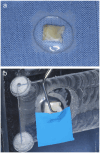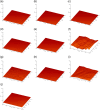Impact of air-polishing using erythritol on surface roughness and substance loss in dental hard tissue: An ex vivo study
- PMID: 38408064
- PMCID: PMC10896509
- DOI: 10.1371/journal.pone.0286672
Impact of air-polishing using erythritol on surface roughness and substance loss in dental hard tissue: An ex vivo study
Abstract
This ex vivo study aimed to investigate surface roughness and substance loss after treatment with different professional cleaning methods and to determine whether subsequent polishing with a rubber cup and polishing paste is necessary. Samples (flat and natural surfaces) of human enamel and dentin were prepared (baseline) and treated with either a curette, air-polishing with erythritol, a rubber cup and polishing paste, or a combination thereof (treatment). Subsequently, all samples were immersed in an ultrasonic bath (ultrasonic) to remove residues from the treatment procedures. The surface roughness values sRa and sRz as well as tissue loss were measured profilometrically. Linear regression models were used to compare group differences (roughness and loss) considering the corresponding baseline value. The significance level was set at p<0.05. sRa increased significantly after treatment with curettes or air-polishing with erythritol in both enamel (p<0.001) and dentin (p<0.001) of flat samples. The same effect was observed for sRz in dentin (p<0.001) but not for enamel compared to negative control. Polishing with a rubber cup and paste alone had no significant effect on roughness values. When combined with other treatments, the effect of curette or air-polishing with erythritol dominated the effect. In enamel, none of the tested methods led to measurable tissue loss. In dentin, air-polishing with erythritol caused ≤50% tissue loss compared to the curette. Conclusively, for enamel, treatment effects on roughness were measurable but of limited clinical relevance. For dentin, air-polishing resulted in a smaller but insignificant roughness increase and less tissue loss compared to the curette. Polishing with a rubber cup and paste did not affect surface roughness. Regarding the clinical application, the use of air-polishing seems to be a less invasive procedure than using a curette; polishing with rubber cup and paste offers no advantage in terms of reducing roughness as a final procedure.
Copyright: © 2024 Kruse et al. This is an open access article distributed under the terms of the Creative Commons Attribution License, which permits unrestricted use, distribution, and reproduction in any medium, provided the original author and source are credited.
Conflict of interest statement
The authors have declared that no competing interests exist.
Figures






Similar articles
-
Colour Changes and Surface Roughness After Air-Polishing for Tobacco Stain Removal.Int Dent J. 2025 Apr;75(2):1409-1419. doi: 10.1016/j.identj.2024.11.008. Epub 2024 Dec 20. Int Dent J. 2025. PMID: 39709239 Free PMC article.
-
Impact of air-polishing with erythritol on exposed root dentin: A randomized clinical trial.Int J Dent Hyg. 2025 Feb;23(1):63-72. doi: 10.1111/idh.12835. Epub 2024 Jun 9. Int J Dent Hyg. 2025. PMID: 38852146 Free PMC article. Clinical Trial.
-
Tooth Surface Comparison after Air Polishing and Rubber Cup: A Scanning Electron Microscopy Study.J Clin Dent. 2016 Mar;27(1):13-18. J Clin Dent. 2016. PMID: 28390211
-
In Vitro Study of Surface Changes Induced on Enamel and Cementum by Different Scaling and Polishing Techniques.Oral Health Prev Dent. 2021 Jan 28;19:85-92. doi: 10.3290/j.ohpd.b927695. Oral Health Prev Dent. 2021. PMID: 33511822 Free PMC article.
-
Air polishing: a review of current literature.J Dent Hyg. 2013 Aug;87(4):173-80. J Dent Hyg. 2013. PMID: 23986410 Review.
Cited by
-
Colour Changes and Surface Roughness After Air-Polishing for Tobacco Stain Removal.Int Dent J. 2025 Apr;75(2):1409-1419. doi: 10.1016/j.identj.2024.11.008. Epub 2024 Dec 20. Int Dent J. 2025. PMID: 39709239 Free PMC article.
-
Impact of air-polishing with erythritol on exposed root dentin: A randomized clinical trial.Int J Dent Hyg. 2025 Feb;23(1):63-72. doi: 10.1111/idh.12835. Epub 2024 Jun 9. Int J Dent Hyg. 2025. PMID: 38852146 Free PMC article. Clinical Trial.
References
-
- Graumann SJ, Sensat ML, Stoltenberg JL. Air polishing: a review of current literature. J Dent Hyg. 2013;87:173–80. - PubMed
-
- Barnes CM, Covey D, Watanabe H, Simetich B, Schulte JR, Chen H. An in vitro comparison of the effects of various air polishing powders on enamel and selected esthetic restorative materials. J Clin Dent. 2014;25:76–87. - PubMed
-
- Camboni S, Donnet M. Tooth Surface Comparison after Air Polishing and Rubber Cup: A Scanning Electron Microscopy Study. J Clin Dent. 2016;27:13–8. - PubMed
MeSH terms
Substances
LinkOut - more resources
Full Text Sources

